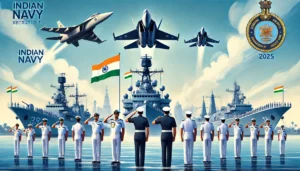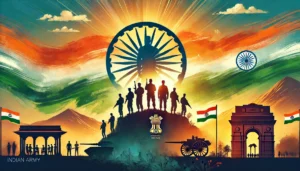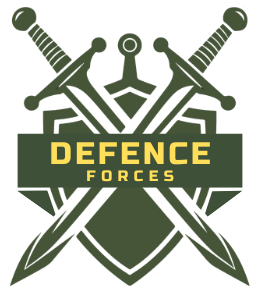defenceforcesindia.in
Indian Defence Forces
Introduction
- Overview of the Indian Defence Forces
- Importance of the Defence Forces in National Security
The Structure of the Indian Defence Forces
- Three Main Branches
- Role of the Ministry of Defence
- History and Evolution of the Indian Army
- Key Functions and Responsibilities
- Structure of the Indian Army
- Corps and Divisions
- Regiments and Battalions
- Origins and Early Days of the Indian Navy
- Strategic Importance of the Indian Navy
- Structure of the Indian Navy
- Naval Fleets and Commands
- Submarines and Aircraft Carriers
- Formation and Development of the Indian Air Force
- Air Defence Strategy of India
- Structure of the Indian Air Force
- Fighter Squadrons and Helicopter Units
- Airbases and Radar Systems
Roles and Responsibilities of Each Force
- Defence of Land, Sea, and Air
- Peacekeeping and Disaster Relief Missions
Training and Education in Indian Defence Forces
- Prestigious Military Academies
- Continuous Skill Development Programs
Modernisation and Technological Advancements
- Development of Indigenous Defence Technologies
- Collaborations with Other Countries for Defence Equipment
Women in the Indian Defence Forces
- Integration of Women in Various Roles
- Major Milestones Achieved by Women in Defence
Special Forces of India
- National Security Guard (NSG)
- Marine Commandos (MARCOS)
- Garud Commando Force
Defence Budget and Expenditure
- Allocation of Funds for Defence
- Defence Research and Development Organisation (DRDO) Contributions
India’s Nuclear Arsenal and Defence Strategy
- India’s No-First-Use Nuclear Policy
- Strategic Missile Forces
International Cooperation and Peacekeeping
- India’s Role in United Nations Peacekeeping Missions
- Defence Partnerships with Other Countries
Challenges Faced by Indian Defence Forces
- Geopolitical Threats
- Internal Security Issues
Conclusion
- Future of Indian Defence Forces
- Importance of a Strong Defence System in a Globalised World
FAQs
Indian Defence Forces: A Pillar of National Security
The Indian Defence Forces are one of the most robust military systems in the world, playing a crucial role in safeguarding the country from external and internal threats. These forces, composed of the Indian Army, Navy, and Air Force, ensure that the nation’s sovereignty is maintained, while also engaging in humanitarian missions and peacekeeping operations across the globe.
The Structure of the Indian Defence Forces
The Indian Defence Forces are divided into three main branches: the Indian Army, Indian Navy, and Indian Air Force. These forces operate under the Ministry of Defence, which is responsible for coordinating all military activities and ensuring national security.
Indian Army
History and Evolution of the Indian Army
The Indian Army is the land-based branch of the defence forces and has a rich history that dates back to ancient times. Over the centuries, the Army has evolved into a modern fighting force, ready to meet any challenge on the ground.
Key Functions and Responsibilities
The Indian Army’s primary role is defending the nation’s borders. It is also actively involved in counter-terrorism, peacekeeping missions, and disaster relief operations.
Structure of the Indian Army
- Corps and Divisions: The Indian Army is organised into several corps, each consisting of divisions. These divisions are further divided into brigades, regiments, and battalions, each with specific operational roles.
- Regiments and Battalions: Infantry regiments and battalions are the backbone of the Army, trained for various combat situations.
Indian Navy
Origins and Early Days of the Indian Navy
The Indian Navy’s roots can be traced back to 1612, during British rule, but it became fully operational after India’s independence. The Navy plays a critical role in protecting India’s vast maritime borders and interests.
Strategic Importance of the Indian Navy
India’s geopolitical position makes the Navy essential for safeguarding trade routes and the exclusive economic zone. The Navy also plays a key role in anti-piracy missions and providing disaster relief in coastal areas.
Structure of the Indian Navy
- Naval Fleets and Commands: The Indian Navy operates several fleets, including the Eastern and Western Naval Commands.
- Submarines and Aircraft Carriers: Advanced submarines and aircraft carriers like INS Vikramaditya ensure the Navy’s supremacy in the Indian Ocean.
Indian Air Force
Formation and Development of the Indian Air Force
The Indian Air Force (IAF) was established on 8 October 1932 and has since grown into one of the most sophisticated air defence systems in the world.
Air Defence Strategy of India
The IAF is responsible for safeguarding the country’s airspace, conducting aerial warfare, and providing crucial support to ground troops during military operations.
Structure of the Indian Air Force
- Fighter Squadrons and Helicopter Units: The Air Force operates a range of fighter jets, including the Sukhoi Su-30MKI and Rafale, alongside advanced helicopter units for transport and rescue operations.
- Airbases and Radar Systems: A network of strategically located airbases and radar systems ensures continuous surveillance of Indian airspace.
Roles and Responsibilities of Each Force
Each branch of the Indian Defence Forces has unique responsibilities:
- The Indian Army defends the land.
- The Indian Navy secures maritime borders.
- The Indian Air Force controls air defence.
Together, they form a unified front against any threat to national security, while also participating in international peacekeeping efforts and humanitarian missions.
Training and Education in Indian Defence Forces
India’s military academies, such as the National Defence Academy (NDA) and Indian Military Academy (IMA), provide rigorous training. Continuous skill development programs ensure that personnel remain at the cutting edge of military tactics and technology.
Modernisation and Technological Advancements
India is investing heavily in the modernisation of its defence capabilities. Indigenous development of weapons and technology, such as the Tejas fighter jet, showcases the country’s commitment to self-reliance in defence production. Additionally, collaborations with countries like the U.S., Israel, and Russia have enhanced India’s technological prowess.
Women in the Indian Defence Forces
In recent years, women have made significant strides in the Indian Defence Forces. From commanding units to flying fighter jets, women are breaking barriers in roles that were traditionally male-dominated.
Special Forces of India
India’s elite Special Forces units are renowned for their precision and bravery:
- National Security Guard (NSG): Known as the Black Cats, they handle counter-terrorism operations.
- MARCOS: The Navy’s Marine Commandos are experts in sea-based covert operations.
- Garud Commando Force: Specialised in air assault missions.
Defence Budget and Expenditure
India allocates a substantial portion of its budget to defence, enabling the purchase of modern equipment and the development of advanced technologies. The Defence Research and Development Organisation (DRDO) plays a crucial role in designing and manufacturing indigenous weapons systems.
India’s Nuclear Arsenal and Defence Strategy
India follows a No-First-Use nuclear policy but maintains a strong nuclear deterrent. The country’s strategic missile forces, including the Agni series, provide a robust second-strike capability.
International Cooperation and Peacekeeping
India has been an active participant in United Nations peacekeeping missions and has defence agreements with several nations, including Russia, France, and the U.S.
Challenges Faced by Indian Defence Forces
The Indian Defence Forces face numerous challenges, including geopolitical tensions with neighbouring countries and internal security issues such as insurgency and terrorism.
Conclusion
The Indian Defence Forces are a critical pillar of national security. As India continues to modernise and strengthen its defence capabilities, its forces remain prepared to meet future challenges and protect the country’s sovereignty.
FAQs
What are the three branches of the Indian Defence Forces?
The Indian Defence Forces consist of the Indian Army, Indian Navy, and Indian Air Force.What is the primary role of the Indian Army?
The Indian Army is responsible for defending the nation’s land borders and engaging in counter-terrorism and peacekeeping operations.What are some of the key aircraft used by the Indian Air Force?
The Indian Air Force operates advanced aircraft like the Sukhoi Su-30MKI, Rafale, and Tejas.How is the Indian Navy structured?
The Navy is divided into fleets and commands, with advanced submarines and aircraft carriers ensuring maritime security.What are the challenges faced by the Indian Defence Forces?
Challenges include geopolitical tensions with neighbouring countries, internal security threats, and the need for modernisation.
Indian Air Force Recruitment 2025: Apply Now for Agniveervayu (Sports) Intake 02/2025

CISF Recruitment 2025: Apply for 1124 Constable/Driver & Other Posts – Check Eligibility, Salary & Selection Process

Indian Navy Recruitment 2025: Apply Online for 270 Vacancies – Check Eligibility, Salary & Selection Process

Indian Army Recruitment 2025: Apply Now for 381 Vacancies Before 05 February

Ministry of Textiles Recruitment 2025: Apply for Junior Weaver, Junior Assistant, and Other Posts

Ministry of Finance Recruitment 2025: Apply for Inspector and Assistant Positions
Recent Posts
- Indian Air Force Recruitment 2025: Apply Now for Agniveervayu (Sports) Intake 02/2025
- CISF Recruitment 2025: Apply for 1124 Constable/Driver & Other Posts – Check Eligibility, Salary & Selection Process
- Indian Navy Recruitment 2025: Apply Online for 270 Vacancies – Check Eligibility, Salary & Selection Process
- Indian Army Recruitment 2025: Apply Now for 381 Vacancies Before 05 February
- Ministry of Textiles Recruitment 2025: Apply for Junior Weaver, Junior Assistant, and Other Posts

